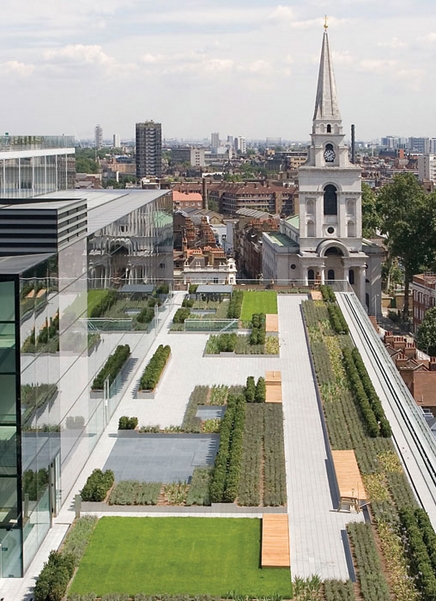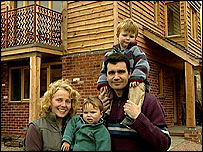
- •Introducton (предисловие)
- •Unit I sustainability and “green” building
- •1. Read the following information about sustainability, matching questions with the answers.
- •2. Now look at the two diagrams and try to explain their meaning.
- •1. Read the construction credo of eco-architects engaged in sustainable construction and comment on it. Do you share it? Which part has impressed you most?
- •2. Now read the text trying to grasp the idea of sustainability. Make sure you know these words:
- •Sustainability
- •3. Answer the following questions:
- •1. Read the following news and try to guess what ideas they have in common and what problems they deal with.
- •Sustainable Architecture Questions and Answers
- •1. Read some information about Kelly Hart – a green building professional. Then think of some questions you would like to ask him.
- •2. Now read the interview itself. Have any of your questions been answered in it?
- •3. Answer the following questions:
- •Read what green building is and then discuss why it is one of the most topical environmental issues nowadays. Make use of the information given after the text.
- •2. Here are 10 principles of green building. Look through them and try to predict what each of them is about. Then read the extracts below and match them with the corresponding principles.
- •3. Answer the questions:
- •4. Divide into two groups and collect the arguments for and against the green building approach. Then discuss them in class.
- •5. Find the information about the application of this approach in our country.
- •Earth Cycle
- •1. Go over the vocabulary list. Consult a dictionary if you need:
- •2. Read the first part of the text and answer the questions after it.
- •3. Answer the following questions to part I:
- •4. Read the second part of the text and answer the questions after it.
- •5. Answer the questions to part II:
- •6. Decide whether the following statements are true or false according to the text.
- •7. What is not mentioned in the text?
- •8. What do you think:
- •Fill in the gaps with the words below:
- •Think of not less than 5 sentences of your own using the words and word-combinations from the previous exercise.
- •Complete the sentences with the suitable preposition, if necessary.
- •Translate the following sentences from Russian into English:
- •18. Look through some information about underground construction and answer the following questions:
- •Advantages of building underground
- •19. Look through the unit again and make notes under the following headings. Then use your notes to talk about sustainability and green building.
- •1. Do this questionnaire to find out how green you are. Make use of the list of unknown words at the end of it. Then discuss the results in class.
- •Time for fun
- •Unit II renewable energy and construction
- •1. Read the following news and try to guess what ideas they have in common and what problems they deal with.
- •Renewable Energy
- •1. Before reading the text try to answer the following questions:
- •2. Read the text and check your answers.
- •3. Fill in the table.
- •4 . Read the text again and make questions. Answer them.
- •5. Choose any source of energy and make a short presentation. Try to use additional information.
- •1. Read the text and answer the questions after it. What is a passive house?
- •Elements of passive solar design
- •Peculiarities of passive solar construction
- •1. Space heating
- •3. Air tightness
- •4. Ventilation
- •6. Lighting and electrical appliances
- •2. Answer the following questions:
- •Read the following information and try to guess what type of house is described in each paragraph.
- •3. Look at the title trying to predict the contents of the text. Then read the introduction to the text. Were your answers correct?
- •4. Read part I and answer the questions after it. Building for the future
- •5. Answer the questions to part I:
- •6. Read part II and answer the questions after it.
- •7. Answer the questions to part II:
- •8. Decide whether the following statements are true or false according to the text:
- •Match the words with their synonyms:
- •Match the words with their antonyms:
- •Match the words with their definitions:
- •Fill in the gaps with the words below making all necessary changes to them:
- •Think of not less than 5 sentences of your own using the words and word-combinations from the previous exercise.
- •Complete the sentences with a suitable preposition. You can choose from the following ones: up, with, of, at, by, in, out, for, via. Some of them can be used more than once.
- •Read the following quotations and try to guess people from which spheres of life and of what professions they could belong to:
- •Translate the following sentences from Russian into English:
- •22. Read the news dating May, 2000 and check whether Rolph Disch’s ideas have been realized. Were your predictions about the chances of the new type of houses to get ground correct?
- •23. Study the information below and then try to give a reasoned explanation to the fact that wood is a favourite building material of Hubert Fritz and his followers.
- •24. What is the best summary of the previous extract?
- •25. Look through the unit again and make notes under the following headings. Then use your notes to talk about ecologically-friendly architecture and construction.
- •1. Look at the pictures of these six houses. Do you think they have anything in common? Read the descriptions below and match them with the corresponding houses.
- •2. Answer the following questions:
- •Time for fun
- •Unit III from pyramids to skyscrapers
- •1. Work with a partner. Which of these people have you heard of? Why are they famous?
- •2. Read their quotations. Which do you agree with?
- •3. Do you know any modern architects and constructors? What can you tell about them? Discuss with your partner, then the group.
- •Work in groups and answer the questions.
- •Read the text and check your answers The History of Skyscrapers
- •Match the building with the year of its creation:
- •Make questions for these answers:
- •6. Look through some additional information about skyscrapers.
- •Sustainability
- •1 . Read the following news and try to guess what ideas they have in common and what problems they deal with.
- •Work in groups. Which world famous buildings do the pictures illustrate?
- •Translate the following word-combinations from the text.
- •Read the text and put these phrases in the correct place:
- •Buildings that Scrape the Sky
- •Answer the following questions:
- •Put these events in the chronological order:
- •Skyscraper
- •Diagrams
- •Skyscraper
- •Skyscraper
- •Reading task e
- •1. Go over the vocabulary list. Consult a dictionary if you need.
- •2. Note the pronunciation of the construction companies, personal and geographic names in the article and try to present them in your native language:
- •3. Note the abbreviations and symbols in the article:
- •Adding a Notch to the City Skyline
- •8. Answer the questions to parts I and II:
- •9. Read part III and answer the questions after it. Make sure you can explain the following terms and word combinations from part III.
- •Answer the questions to part III:
- •Read part IV and answer the questions after it. Make sure you can explain the following terms and word combinations from part IV.
- •Answer the questions to part IV:
- •Answer the questions to part V:
- •Decide whether the following statements are true or false according to the text:
- •What do you think:
- •17. Make up the plan of the text.
- •18. Make a summary according to your plan. The following word-combinations will help you:
- •Match the words with their synonyms:
- •Match the words with their antonyms:
- •Match the words with their definitions:
- •What do we call: (use the words from the list below)
- •Arrange the following words into groups according to the part of speech. Pay attention to their suffixes and prefixes.
- •Complete the sentences with a suitable preposition. You can choose from the following ones: from, as, to, with, about, of, for. Some of them can be used more than once.
- •Translate the following combinations of noun groups and colloquial expressions. Then choose any 10 items and make up your sentences or find the similar ones in the article.
- •Fill in the correct words from the list below and translate the following sentences into your native language:
- •Translate the following sentences from Russian into English:
- •Look through the article again and make notes under the following headings:
- •Now talk on the subjects:
- •Read and learn the poem. Say, whether 26 storeys is enough to qualify a building as a skyscraper? Questions Regarding Skyscrapers
- •Answer the following questions:
- •32. There exist several problems associated with the skyscrapers:
- •T he Barometer Problem
- •Texts for supplementary reading Text 1 Technical Terms
- •Text 2 The Seven Wonders of the Ancient World
- •Italy's green primary school
- •Is Concrete Environmentally Friendly?
- •Working with Concrete
- •Disposing of Concrete
- •Text 5 Green cement: an industry revolution?
- •The Bed zed Project, London
- •Slateford Green Housing, Edinburgh
- •The Findhorn Foundation Eco-Village
- •Text 7 Sustainable Architecture Can Help Reduce Carbon Dioxide Emissions
- •Text 8 gkk Design Corporatist Frankfurt Skyscraper
- •Text 9 Milan Convention Centre Offers Glacial Roof
- •Text 10 Artotel Eyes Up Shoreditch Hotel Site
- •Text 11 Skinny Tower Nears Completion In Paraguay
- •Text 13 Metamorphosis
- •References
3. Answer the following questions:
How do you understand the way of building "sensitive to its location and the culture that has shaped it”?
What is the linking element of the past, present and future in building?
Can you explain what it means “to think holistically”?
What process distinguishes the work of an eco-architect?
What is the essence of this process?
What changes took place in our society in the last decades?
Why is environmental awareness called “an integral part of the practice’s culture”?
4. According to the text what are the constituent parts of the best architecture? Discuss each of them in pairs. Put them into the order of importance from your point of view. Make use of the following conversational formulas:
To my mind…
In my opinion…
As for me…
If you ask me…
As I see it…
I’d like to point out that…
I can’t but mention …
Reading task B

1. Read the following news and try to guess what ideas they have in common and what problems they deal with.
Eco-terraces: Urban jungle
E Arup Associates’ design for Ropemaker includes four eco-terraces cascading down one side of the building. Gary Alden, a senior landscape architect, says: “Standard green roofs have become popular and clients and architects see the potential to make them into useable terraces. It becomes a unique selling point for these buildings.” Lee Hosking, an architect with Arup Associates, says the decision to incorporate useable roof is often dictated by the type of building. “If it’s a tall, slim tower, you don’t have much of a chance. But if you have a low-rise building or one that is a series of steps, you consider it straightaway.” Councillor Graham Wilkes at the "secret garden"
W But one part of the building remained unseen until Tuesday - a secret garden above the heads of the passengers. Thousands of tiny rock plants have been planted on the roof in an attempt to reduce pollution from the buses and protect the roof at the same time. It is believed to be the first scheme of its kind. Councillor Graham Wilkes, of Walsall Council, said: "This garden was put down to protect the membrane underneath and stops wet penetrating the concrete. It also takes in ultra-violet light and infra-red light and is very environmentally friendly.” Mr Wilkes added: "In another 12 months the garden will be really green. This has never been tried anywhere else and if successful, I can see it going to other places." |
Minister welcomes new green building code
P “The code should ensure consistency of approach between all policies, tools, guidance and initiatives. It should set the standards, metrics and targets that all sustainability tools should be aligned to and compliant with.” “At the moment the practical delivery and management of sustainable buildings is being held up by a confusing myriad of different policies, regulations, tools and standards.
Britain's new, greener neighbourhoods
A It looks like it has come straight out of a children's story-book. Each house is a different shade of fruit pastel: raspberry red, custard yellow, lime green. This is the Wintles, a new development of 40 houses on the edge of the town of Bishop's Castle. The buildings are actually designed with some sobering realities in mind: the fact that the planet is getting warmer. The fact that our homes make up around 27% of the UK's carbon emissions; and the target set by the government of reducing our carbon output by 60% by the year 2050. The designer Bob Tomlinson insists the Wintles is a modern development: "We set out to build houses appropriate for the time in which we live. We felt most builders now are using designs from the 1970s and so we looked at what was happening in North America and Scandinavia and came up with a very light and environmentally efficient house.” |
Reading task С

 co-terraces
are the next big thing in rooftop developments, says Stephen
Kennett. It pays to have green fingers.
co-terraces
are the next big thing in rooftop developments, says Stephen
Kennett. It pays to have green fingers.
 alsall's
bus station provoked mixed reactions for its modern architecture
when it opened last year.
alsall's
bus station provoked mixed reactions for its modern architecture
when it opened last year.
 lanning
minister Margaret Beckett gave a cautious welcome last week to the
UK Green Building Council's proposed Code for Sustainable
Buildings. The minister said: “I am very willing to listen to
people coming forward with ideas to reduce carbon emissions.
lanning
minister Margaret Beckett gave a cautious welcome last week to the
UK Green Building Council's proposed Code for Sustainable
Buildings. The minister said: “I am very willing to listen to
people coming forward with ideas to reduce carbon emissions.
 developer in Shropshire is building one of the greenest and most
neighbourly housing schemes in the country.
developer in Shropshire is building one of the greenest and most
neighbourly housing schemes in the country.